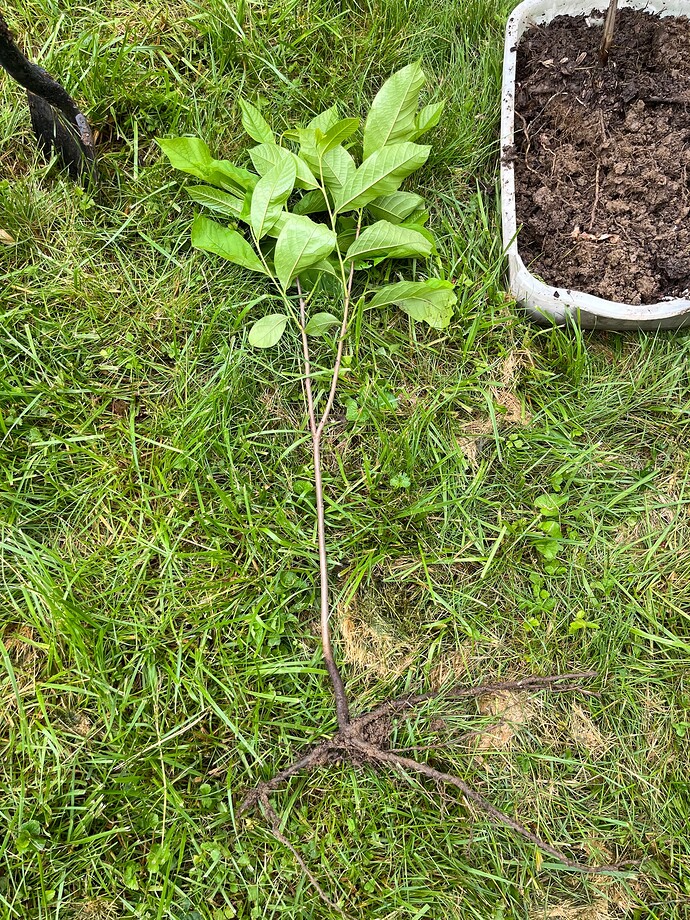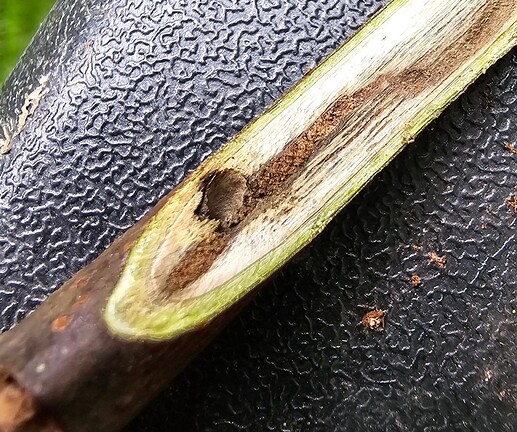My only three pawpaws were all purchased as 1-gal twigs from Raintree in spring 2021. They are Prolific, Shenandoah, and Susquehanna. Out of those, Susquehanna has been by far the most vigorous, is now almost twice the size of either of the others. Prolific has grown so slowly that I was worried it might not make it (just a few leaves per season), while Shenandoah grew steadily but less vigorously than Susquehanna.
Mine were from Nash, OGW, and Buzz. All failed at the graft. I grafted other varieties to the stock with no issues yet.
That is so strange, I was curious if you both had gotten trees from the same place. I dream of a day when pawpaw cultivars are sold on their own roots. Seems like the graft union presents a weak point for cultivars. Grafted trees will always have a place but it would be nice…
I am not so sure it’s a rootstock issue, I wonder if maybe Susquehanna tends to not store enough energy in its wood to make it through a long winter season. Here in Seattle, it turned fall colors starting in late September and this is what it looked like by mid-late October right before it dropped its last leaves:
My pawpaws only started leafing out less than a month ago, and still haven’t finished expanding their first leaves.
@swincher, something definitely is off with your tree. I wonder if there is a nitrogen deficiency of some sort that makes it go dormant early? Or root damage?
If no root damage, I would suggest feeding your trees urea 45-0-0 and possibly sulpomag to treat any other possible deficiencies.
All three pawpaws went dormant around then. I’ve been feeding them with fish emulsion pretty regularly through the growing season, and their leaves looked healthy and green until the sun angle dropped low enough that they stopped getting any sun on the leaves either. They are planted in a location that is a cold microclimate in my yard (against the southern fenceline in the shade of my neighbor’s house), with little to no direct sun on the soil itself even in the summer, so I figured it was just cold soil temperatures triggering the dormancy.
I have a hypothesis that pawpaws are somewhat self pruning. I haven’t had place to grow anything long enough to know if this is a clear thing or not, but not so vigorous scion on a more vigorous rootstock would leave the grafts on the most likely to go branches.
I’m thinking this because I find a lot of stems dead only back to a clean break with a larger branch each year. All of mine are young trees. They were an unidentified nursery stock and I have heavily grafted them. Tiny graftwood is generally a waste of my time, but as a novice, a lot of my time is “wasted” just seeing how things are done, so not a big deal for me.
They are nowhere near as self-pruning as a persimmon. With those, you can almost always go through even before bud break and knock off dead branches with no effort and a clean break at the parent stem.
Sunflower seems pretty strong. They were my first grafts and I got 100% take and all of those are still solid three years in. Al Horn were some of my last grafts, grafted late using very aged scion, and while the growth this spring is low, they almost all healed over and have given me encouragement out of the gate after their first winter.
I’ve played with scion from multiple places of multiple cultivars, and a significant portion just seem to give up, taking at least a few inches of branch below the graft with it. I can’t say what luck I’ve had with bud grafts. I don’t feel confident with them. and the various ways of labeling I’ve tried don’t really cooperate with my wind and rain. Since pawpaw heals fairly cleanly, I won’t know any better until they get old enough to consider giving me fruit. Or until I find my older notes and compare to the trees. I’m much more efficient with what goes into the computer.
A lot of my larger trees will show some life in the terminal central leader bud during leaf out, but it seems most of the energy rapidly goes toward branching off of the previous season’s nodes and the leader gets abandoned. My Chappell is pushing 8ft tall now and I’m about done trying to train the top growth straight upward on that one although I’m still tempted. Some of my smaller seedlings don’t fully harden off the youngest growth before the first freeze so that may explain some tip dieback as well.
Anyway, wasn’t initially feeling up for it, but kicked myself in the rear and got 3 more grafts done on seedlings…Atwood, Dr. Chill, and Cantaloupe. I think that’s 11 down and 9 to go. I still have 3 seedling field grafts to do and I’m wavering between NC1, Halvin, Green River Belle, Wabash, and Cawood. The other 4 remaining are Rebecca’s Gold (kind of an accident), Central, SMC’s unknown pineapple, and KY Champion. Do any of these tend to be more vigorous over the others?
My guess would be KYC but not 100% sure.
Question: If someone wanted to graft some pawpaw root runners this week, I suggested they don’t severe the main root to the runner yet. Do it in the fall.
Like they should have done it last fall so it created its own feeder root system, … but since they didn’t its prob good to let the graft grow without shock, then shock it this fall by cutting around it so it can grow its own roots by next spring (but it would have already put alot of growth on the graft so it shouldn’t lose the graft is my thinking).
Does that sound good advice?
I dug up a rootsucker this spring(fully leafed out), and it had very little feeder roots. Transplanted it and grafted it since the new growth was wilting anyway. It is pushing new growth from the graft but would have probably grown more if I hadnt dug it up and grafted it in place. They are pretty tough plants but I agree with your advice. Graft now and sever in the fall. Dig it just before budbreak in the spring
Found this in some scion I’m working through. Boring insect? Is it safe to use? (Will it even take when it’s damaged like this?)
“Is it safe to use.”
I’m no expert and we have a lot in here who may respond soon, but from a neutral observer side, unless you have an expendable plant to put this on and it is a scion you can’t replace, the pic shows me several things that make me uncomfortable.
The hole itself presumable exits on the side we can’t see. If it does, alone, the cambium itself seems largely intact, so the graft should probably heal. If it doesn’t exit, what effects is fluid going into that hole (or not) likely to have on the pressures on the graft while it heals, or long term strength, once it does?
The pithy brown stripe across your cut is not confined to central or specific fibers, so I assume it is from either the edges of a longer burrow whatever made or an infection intruduced by it or it’s damage.
The fibers around it are mottled/darkened which reminds of mildew or the like. This, the above, and the below suggest risk to the roostock plant from an introduced pathogen.
The bit of exterior bark also displays a lot of spotty desication, which also suggests more than casual issue for the plant it was taken from.
In the balance, if you have the materials to sacrifice, and if the effort works for you, I’d look for a nice bud to graft instead of using the whip itself.
There is something I tend not to do right for bud grafts, and I suspect it is not keeping the bud itself sterile enough. I haven’t killed a tree yet, but if I have had any success at all, it is with something that will actually grow out next year or something that healed so cleanly that I won’t know it was an improperly labeled graft until I notice that growth does not match the nurse stock. Usually I either see cambium healed, a full pit where my bud was, or the remains of my labeling attempt, so my money would be on my own inadequacy pretty close to across the board with this effort, although pawpaw heals fairly cleanly for me, and my early label attempts were their own learning curve. My luck, I also may have even rubbed new growth off because it was closer than I wanted to a visible graft.
My feelings too. But I’m also not an expert ![]()
What insects go after pawpaws like that ? Ambrosia beetle be4 the standard tubes sticking out of the tree? or something else?
I know of pawpaw peduncle borer and ambrosia beetle as ‘in wood’ options but as far as I know, I haven’t battled either to date and could only speculate. Maybe others have a better idea.
If I was trying to use that wood to salvage a rare variety, I’d absolutely investigate if the other side is also open, and if not, try to use a needle or some other object to poke and remove whatever caused that hole.
The people I consider experts are usually the ones humble enough not to admit it to the rest of us ![]()
I’m never an expert. Gifted amateur maybe. ![]()
I’m not sure I’m willing to accept that you’re not one of the experts on this species. LOL
@Mtncj @TrilobaTracker @armyofda12mnkeys @disc4tw
Thank you for the thoughtful input. I did have a second cutting; it was Summer Delight so I’m confident I could get my hands on it again if I had to. The other cutting to my recollection showed no signs of damage. I did cut through the rest of the bad stick and found nothing other than the brown debris continuing on through. I am tempted to unwrap the other one and double check though.
A lesson to me that scrutiny of each stick for damage is important.


